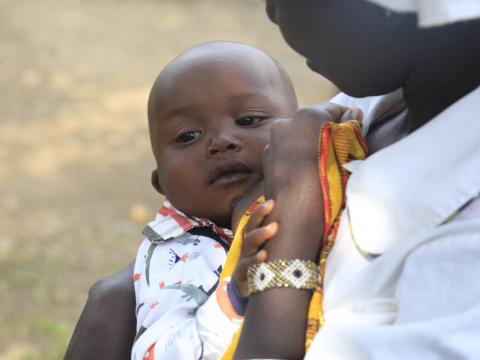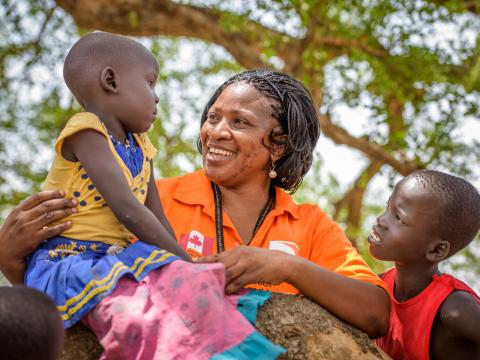Health in Emergencies
Health in Emergencies
Health is a critical determinant for survival in emergency. World Vision's Health and Nutrition Emergency Response reduces mortality and disease burden in vulnerable populations affected by humanitarian emergencies. We restore access to curative and preventative health and nutrition services. Our response framework and programmes are aligned to the Sphere Minimum Standards for Health in Action.
World Vision responds to four types of emergencies:
- Rapid Onset: Geophysical (Earthquakes, Landslides, Tsunamis, Volcanic activity); Hydrological (Avalanches, Floods); Meteorological: (Cyclones, Storms / wave surges); Climatological (Wildfire)
- Slow Onset: Climatological (drought, extreme temperatures); Displaced populations
- Complex: National conflict (fighting between groups); International conflict; Displaced populations
- Disease Outbreak/Epidemics: Airborne / person to person (Influenza, Meningitis, Measles, Ebola / Marburg); Waterborne (Cholera & AWD / ABD, Poliomyelitis, Typhoid, Leptospirosis); Vector (Dengue Fever, Zika, Yellow fever, Malaria, Leishmaniasis)
Our Response:
- Vulnerable groups such as women and children can access essential health and nutrition services in the immediate aftermath of a disaster.
- Health and nutrition systems are strengthened to meet the immediate and longer term needs of the affected populations.
- Families and communities are supported to understand, monitor and protect themselves from public health risks, ensure each other’s wellbeing and access to health and nutrition services.
- Early Warning and Surveillance are established to enable rapid detection and response to public health issues of concern.
- Inter-agency level health and nutrition coordination platforms (area / country / regional levels) are supported, effective and meeting key needs of target groups
Maternal Newborn Child Health in Emergency:
During an emergency response, World Vision implements the interventions from our Health and Nutrition Sector Approach, prioritized to the context of the emergency.
The vast majority of childhood deaths in emergency context are due to the same conditions that take lives every year in non-emergency situations. Diarrhoeal diseases, measles, malaria and pneumonia are direct causes of child morbidity and mortality. In emergency conditions, the Health and Nutrition programming interventions are given to provide services to reduce these diseases that lead to child mortality.
Childbirth and Newborn Care:
To prevent excess maternal and newborn death in emergency context, minimum initial services package for reproductive health are to be put into place. These include:
- Establishing a referral network that facilitates transportation and communication to and from the health centre and the hospital, especially for emergency obstetric and newborn care
- Providing clean delivery kits to all visibly pregnant women and to birthing facilities
- Educating the community on healthy childbirth practices, immediate newborn care and early and exclusive breastfeeding
Nutrition for Expectant and Lactating Mothers:
In communities where nutritional needs of the general population are not met, World Vision staff should work with the United Nations World Food Programme to determine the appropriate food needs and nutrition supplementation for both pregnant and lactating women. Even if pregnant and lactating women are receiving fortified foods, UNICEF and World Health Organization recommend a daily multiple micronutrient supplement to meet the mother's needs. Read more on World Vision Nutrition in Emergencies Programming.
Infant and Young Child Feeding:
In emergency context, children become more vulnerable to disease and death. With optimal infant and young child feeding practices, the high risk of undernutrition and death can be reduced. Complementary feeding, which significantly contributes to the prevention of undernutrition and mortality in children after six months of age, should not be overlooked in emergencies. Read more about our Nutrition in Emergencies Approaches. Read 10 Common Myths About Breastfeeding in Emergencies.
WAYCS Approach:
Women Adolescent and Young Children Spaces, or WAYCS, is a WV approach as part of the health response in emergency contexts to enable women to breastfeed in privacy and facilitate peer-to-peer support for breastfeeding, as well as providing skilled support for those who are experiencing breastfeeding challenges or who wish to restart breastfeeding.
Watch this video on creating a space for women to express their needs while accessing life-saving health and nutrition information for their families.
Recent Response Actions
Provided remote support to regional and national offices to the following emergencies in 2015 and 2016: Led the Health and Nutrition operations to Iraq, Syria, Sierra Leone, Ebola Virus Disease Outbreak, Nepal Earthquake and Zika.
Other health responses that were undertaken by World Vision have included access to MNCH services in Iraq(2014), Northern Syria(2013), Haiti Earthquake and Pakistan Floods(2010); and, support to pregnant and young mothers in N.Syria, Philippines(2013) and Pakistan(2009,2010) in addition to supporting bottle fed children involved in the European Migration crisis (2015).
Strengthening and support to the health system to improve access to Maternal and Child Health services: WV responded in Kurdish Region of Iraq(2014), Northern Syria(2013), Haiti Earthquake and Pakistan Floods (2010) by providing basic medical needs and services in addition to training for community health workers. Additionally, in response to the Haiti Earthquake, WV supported 10 hospitals with essential drugs and equipment.
Support for Infant and Young Child Feeding in Emergencies: WV gave access to clean delivery kits in Haiti and Pakistan, N.Syria and KRI. WV provided optimal support to lactating women through Women and Young Child Spaces(WAYCS) and to bottle fed children amidst the European Migration crisis (2015).
Control of communicable diseases: Our response team worked closely with the WASH team in control of disease outbreak in cholera affected areas such as Zimbabwe (2009, 2015), Pakistan (2010) and Kenya (2015).
Management of Acute Malnutrition: With support from UNICEF and WPF, WV worked towards setting up programs, such as Supplementary Feeding Programs (SFP). In addition, in 2022 alone, World Vision treated more than 225,000 children with wasting in 16 countries through its Community-based Management of Acute Malnutrition (CMAM) programme.
Rehabilitation of Health Centers: In response to health centers that were damaged by the disaster, WV rehabilitated centers in Philippines, Nepal, Iran and northern Syria in addition to providing ambulance services in northern Syria
Support to Ebola Affected communities: Through WV Channels of Hope for Ebola (2015), WV worked with faith leaders on providing support to survivors and affected families along with bringing awareness of practices towards Ebola prevention. You can read more on the Ebola Response at this link.

